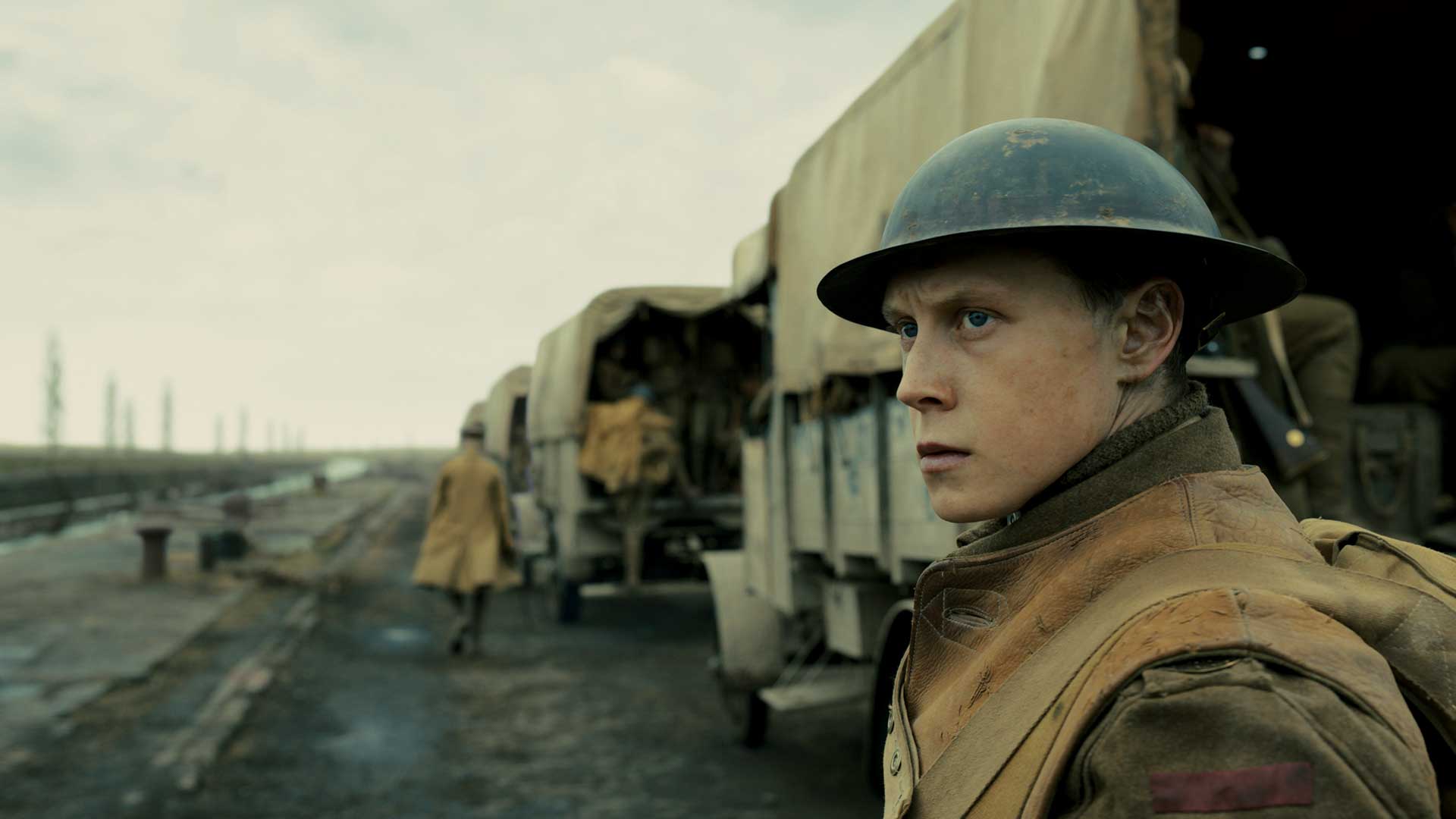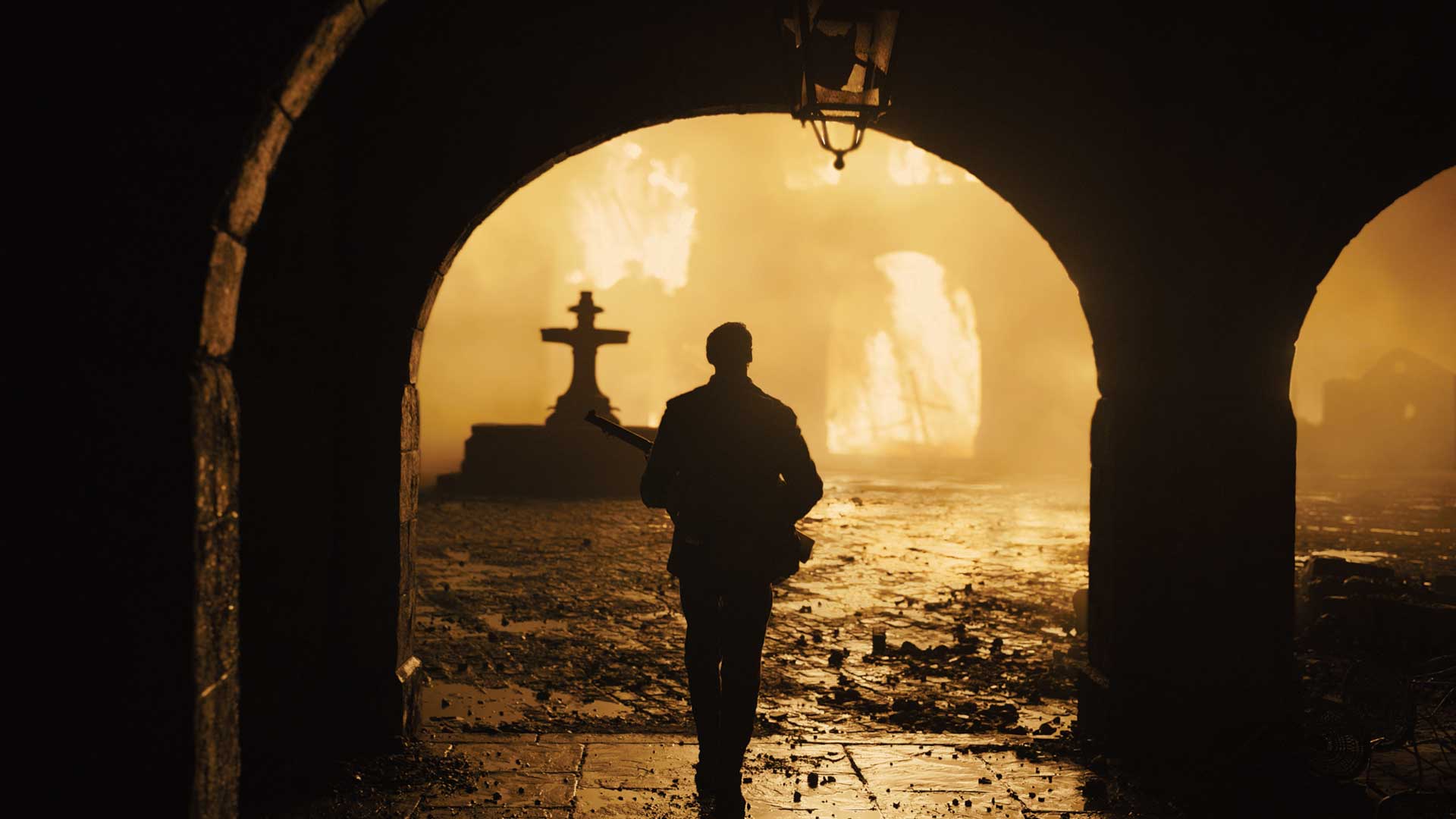Cinema’s fundamental connect is its ability and endless potential to provide the viewer a visceral experience. When done well, the sensation of watching a film is akin to experiencing the real thing itself, or at least to inform you it’s as close as you’ll get. By that principle, Sam Mendes’ 1917 is a resounding success and an astounding film, one that puts you right in the center of the action and like Christopher Nolan’s Dunkirk, leads you through a journey of exhilaration and empathy that will leave you surging and exit the theater with an emotional high.
1917 follows its leads, two Lance Corporals Blake and Schofield played by relative unknowns Dean Charles Chapman and George McKay respectively, who’re tasked with delivering a message to call off a planned attack by the British on the Germans. British forces intend to force the Germans to retreat but recent intelligence suggests that it’s all part of a planned ambush on part of the Germans. With telephone lines disrupted, the lives of 1,600 men depend on them successfully hand-delivering the message. The movie is almost entirely about following these men as they navigate through World War I’s No Man’s Land and endless fields in a race against time to fulfill their duties.
While the plot itself is simplistic and remains so throughout the film’s 2-hour runtime, it’s layered with subtle character developments and interactions that add some weight to the proceedings. Blake has a personal vested interest in the mission, given that his brother is at the other end. He also comes across as hopeful, more optimistic, blessed with a young baby-face and a rawness that leads to erratic, occasionally irrational decisions. Schofield on his part is more experienced, having fought and survived the Battle of the Sommes that had 1 million casualties and awarded a medal for the same. His experiences have made him disillusioned, cynical, resigned and more practical. He cares more for a bottle of wine to quench his thirst for which he trades the medal without any regrets. Their individual traits prove to be their undoing to some extent.

The film’s biggest achievement, and unarguably one that’s being unanimously praised, is that it’s been filmed and edited to look like a one-take shot. In reality, it’s a bunch of long takes that range anywhere between 9 to 11 minutes spliced together although that doesn’t even remotely take away from what 1917 has managed to pull off. And a huge part of this is owed to legendary cinematography Roger Deakins who works with Mendes as well as production designer Dennis Gassner, set artists and editor Lee Smith to plan a series of shots that see the camera move around every conceivable obstacle in its path effortlessly. Whether it’s navigating the jaundiced thin trenches, the muddied pool of wet ooze, booby trapped bunkers, lush fields or a desolate church, the camera goes where the characters go, often leaving you gasping for breath.
I see multiple reviews calling the technique a gimmick that distracts from the film’s core. In sharp contrast, I found it adding significantly to the experience that Mendes, like Nolan, was aiming to create: that of immersion. Employing the singular take lets the film plays out in real-time and brings us closer to the viewpoints of these characters. We follow them on this journey whose highs and lows play out in surreal fashion, fearing for their lives as we hear the reverb of a gunfire or the bang of an explosion. It amplifies the tension and makes every forward move intense. You sweat as the characters take their next step, not knowing where the next bullet might come from. And quite ironically, in an era where the actual battles were a bit more placid and static, Mendes’ writing propels the narrative forward with a constant sense of motion and on to the next thing. For some, it compares to a Call of Duty video game with cutscenes interjected. For me, it’s the closest I’ve gotten to cinematically experiencing the stress on a battlefield after the D-Day Normandy assault in Steven Spielberg’s Saving Private Ryan.
But it’s not cinematography alone that maketh the movie. Lee Smith’s seamless editing is perhaps the film’s most invisible and thankless achievement, stringing together a series of lengthy takes to make it appear like one shot. Dennis Gassner’s production design is incredible, brimming with detail, dead bodies strewn all over, hinting at their own stories of struggle and loss. All the destruction, the sheds, the bunkers are so elaborately designed that you begin to lose sense of what’s real, what’s a prop and what’s extended by green screen. At first, the use of VFX seems impossible to believe. But then it hits you: 1917 does have an Oscar nomination for Best Visual Effects so there’s got to be some trickery involved.
One of the best “tricks” 1917 pulls off is via Roger Deakins’ lighting. At a sequence set in an abandoned, dilapidated burning church, a disoriented Schofield emerges to find flares firing up, lighting the area to create a dance of shadows that repeatedly engulfs him like a Tsunami lashing against shores. As he flees for his life, hellfires burning around him, it creates an almost dreamy sensation, as if Schofield is trapped in his worst nightmares. Deakins uses his wizardry to wonderfully realize the beauty in horrors. The technical complexities it took to execute this are worth reading, for they reinstate in you, the magic of filmmaking. For once, you realize the possibilities when non-CGI fare is pushed to its limits.

Despite its thin storyline, 1917 is loaded with human moments, some of which are difficult to discuss without giving key things away. It’s at once simultaneously heartbreaking to see faith and kindness be so poorly rewarded and yet the triumph of human spirit as for a WWI soldier, duty comes before all. Stacked against overwhelming odds and the practical constraints of covering a 9-mile journey in as many hours, Blake and Schofield symbolize the two beacons of hope in an otherwise bleak, colorless landscape stuffed with grim despair. They carry with them, the hopes of audiences who are fully immersed to see them through the end of the line.
It’s telling how effectively Mendes uses the camera and weaves the shots with his script to reveal layers of information. Consider for instance the opening sequence. It starts off in a peaceful field, almost luring you into a utopia, before slowly beginning to pan backwards as our leads walk towards the screen. It’s then that the soldiers by the sides come into the frame, followed by the messy trenches and the quiet solitude gradually shifts into a chaotic frenzy. In another sequence involving a French woman, the camera first unveils a shaken French lady, then reveals a baby, then reveals the baby is not hers implying a tragic fate of circumstances. The camera is employed like a page in a book; every subsequent move the equivalent of a page-turner that brings with it new morsels of info to grind. A pan to the left reveals a dead horse, a move to the right and a dead body stuns you in focus.
Chapman and McKay aren’t the film’s only characters, however. They’re accompanied by an assortment of high-profile names range ranging from Andrew Scott (Fleabag, Sherlock), Mark Strong (Shazam), Colin Firth (Kingsman: The Secret Service) and most of all, Benedict Cumberbatch (Doctor Strange, The Imitation Game). They cameo in and out of the film and are mostly there for single scenes but make a strong impact and give the general audience something to await. Firth in particular is nearly unrecognizable in his getup while Cumberbatch has a strong presence akin to the Marlon Brando of Apocalypse Now we all build up towards. As stellar is the cast, so is Thomas Newman’s music that dips and rises to push the tension to unimaginable heights. It so brilliantly accompanies the scenes that it’s almost a character in itself, taking us through the film’s emotional highs and lows sometimes subtly, sometimes less so.
A spectacular sequence occurs through the end when a certain character realizes the vanity of jostling through scores of soldiers in claustrophobic trenches and instead takes to sprinting in the open field. It has an intense build-up leading to it and is a moment where everything comes together in perfect harmony; the beautiful cinematography showing scores of soldiers running in the background and the swelling score creates not just a moment but a memory that transcends into an emotional climax that you simply cannot help but rejoice at what you’re witnessing unfold on that IMAX screen.
While 1917 often spells out its character motivations clearly, it’s also a lot more subtle and nuanced with certain revelations. A lot of emotional bits toward the final few minutes count towards this. One which I can consider spoiling is the interaction of an Indian Sardar named Jalandar with Schofield. Where everyone ignores the urgency of the mission, Jalandar is the only one who appears genuinely concerned and empathizes to some extent with what’s at stake. It’s one of those portrayals of Indians in Hollywood that resonated. That the British had invaded India and controlled it at this time doesn’t really play into Jalandar’s attitude. I found that to be an intriguing piece of writing.
As a viewer and an ardent film buff, 1917 to me is a victory of filmmaking. It proves that everything from the writing, the cinematography, the production design, the editing and the music can be brought together by a virtuoso director in the interest of creating something magical. It proves that stirring up human emotions is the best way to engage an audience. And it proves that there’s still awe to be found in the art of filmmaking. Modern technology may have demystified movies and stripped them of some of their wonder but films like 1917 come occasionally and restore your faith in the art of movies. For the love of God, and for the love of Roger Deakins, do not miss this.





